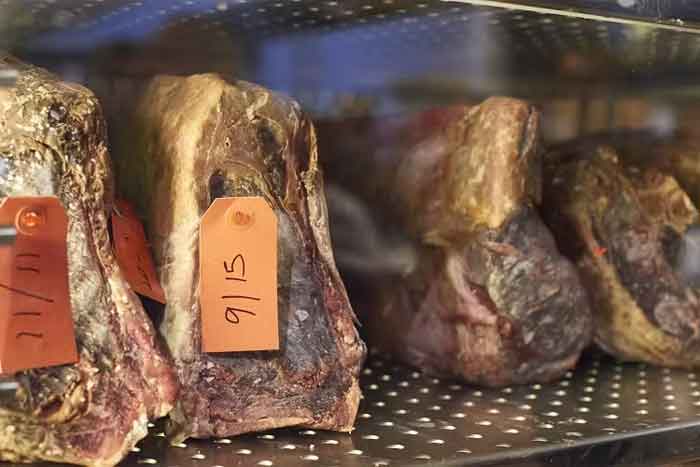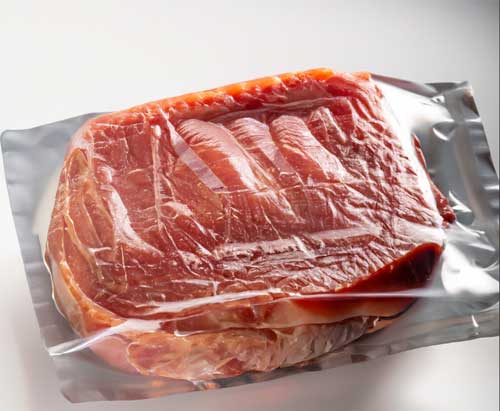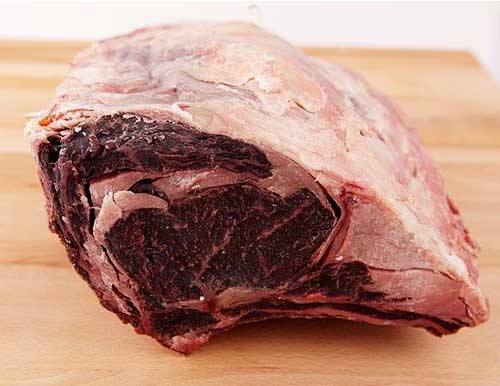
A meat maturation, or “aging,” is one of the oldest methods of improving meat sensory, specifically the tenderness and flavor of beef. The process consists of resting the meat, maintaining a refrigerated temperature for a period of time to improve softness and improve the meat flavor.
It is important to understand why beef becomes more tender as it ages. mature, or grow old. In the living animal, proteins in muscle tissue are constantly broken down and rebuilt. After slaughter, in the meat, decomposition continues, however, obviously, they cannot be reconstructed. Due to the decomposition of muscle fibers, beef becomes more tender. There are special proteins, called enzymes, that are responsible for this decomposition. The enzymes that are most active in the breakdown of meat proteins are called calpains. Calpains “cut” muscle proteins in various regions of the meat fiber, which allows the meat fibers to relax and become softer over time.
Wet maturation and dry maturation
Maturation can be “wet” or “dry”. A wet ripening occurs in vacuum-packed meat for sale, and dry maturation occurs in unpackaged cuts or carcasses. Tenderness improvement is the same whether wet or dry aged, so there is no need to leave cuts or carcasses intact and unpackaged if your purpose is to improve meat tenderness.
Can I age frozen meat?
A maturation This does not happen in frozen beef, as the enzymes responsible for improving tenderness are not active at this low temperature. But maturation will occur, at a slower rate, after the meat has been defrosted. But yield losses due to purging make aging previously frozen meat unfeasible.
The following table derives from research carried out at North Dakota State University and compares the wet and dry maturation of filet mignon during 28 days after slaughter. Wet-aged fillets were vacuum packed and held at refrigeration temperatures, and dry-aged fillets were placed on racks in the same cooler. The results are from a conditioned sensory panel that evaluated softness, juiciness and flavor. There is practically no difference in tenderness and the differences in flavor were also minimal.
| Feature | Wet | Dry |
|---|---|---|
| Softness | 6,14 | 6,12 |
| Succulence | 5,63 | 5,58 |
| Flavor | 0,12 | 0,05 |
How long to mature meat?
Most tenderness improvements occur within the first seven days after slaughter. The improvement in meat tenderness is very limited after 14 days. Information from the National Beef Tenderness Surveys, which are carried out in the USA, shows that, on average, beef takes 14 to 17 days to reach the consumer after slaughter. Therefore, there is generally no need to extend aging periods for most commercially produced beef.
The following table provides information about extended ripening and how tenderness continues to improve over time. This research refers to filet mignons that have been aged for the indicated number of days. Higher values indicate a softer product. Note that there is a continuing tendency for fillets to become more tender as aging periods are increased. There are no essential differences in terms of juiciness and flavor found over time. Other research indicates that beef can take on a more “acidic” flavor as aging time increases.
| Days | 14 | 21 | 28 | 35 | 42 | 49 |
|---|---|---|---|---|---|---|
| Softness | 5,79 | 5,90 | 6,22 | 6,21 | 6,25 | 6,43 |
| Succulence | 5,49 | 5,47 | 5,72 | 5,76 | 5,61 | 5,59 |
| Flavor | 2,83 | 2,80 | 2,79 | 2,78 | 2,75 | 2,73 |
What is the temperature to mature meat?
Other research has shown that the maturation process happens more quickly at higher temperatures; however, the risk of bacterial growth and meat spoilage must be balanced against the need to improve tenderness. As such, it is recommended that meat matures at low temperatures (refrigeration). Temperatures between 0°C and -4°C will allow the meat to mature without resulting in excessive proliferation of bacteria.
Which cuts of meat can be aged?
Cuts that are generally marketed as thick-cut steaks (over 1 inch thick), which include “medium steaks,” which are ribeye, fillet, and rump, respond better to aging than chuck and chuck cuts. hard thigh. Chuck cuts will become more tender as they mature, but to a lesser extent, and tougher cuts, such as duckling, and tough internal and external cuts do not achieve the same improvement in tenderness over time as medium cuts do. These chuck and chuck cuts generally contain larger amounts of connective tissue or cartilage. Furthermore, breasts and other “lean” cuts also do not respond well to aging. This is due to the fact that the tenderness of these cuts is determined more by the amount and type of connective tissue in the meat than the tenderness of the meat proteins. Calpains do not affect connective tissue, so these cuts will remain relatively tougher, even with extended periods of maturation.
Does meat fat influence maturation?
There is evidence that marbling affects the tenderness of various cuts of beef, however, there may also be a relationship between marbling and a cut's response to aging. Research indicates that sirloins with greater amounts of marbling have a greater response to maturation. When comparing sirloin steaks with a content of approximately 5% to 7% of intramuscular fat versus those that had between 2% and 3%, the steaks with a higher content not only demonstrated more tenderness, but also had their tenderness increase at faster rates. The possible reason for this is the type of cattle from which the steaks are obtained, or possibly due to some other mechanism related to calpain activity.
Does the breed of cattle influence the maturation of the meat?
Some breeds of cattle produce meat that will mature at a faster rate than others. Specifically, Brahman-type cattle do not respond as well to maturation as meat from cattle without this genetics. This is due to the activity of the calpain enzyme being lower in the Brahman breed. Academic research indicates that to obtain a similar improvement in tenderization, Brahman meat needs to undergo greater maturation, of around 5 to 7 days, to achieve the same tenderness.





